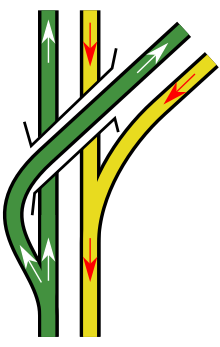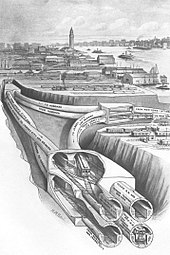Flying junction

 Clash Royale CLAN TAG#URR8PPP
Clash Royale CLAN TAG#URR8PPP 
Flying junction: with a bridge, trains do not block each other
A flying junction or flyover is a railway junction at which one or more diverging or converging tracks in a multiple-track route cross other tracks on the route by bridge to avoid conflict with other train movements. A more technical term is "grade-separated junction". A burrowing junction or dive-under occurs where the diverging line passes below the main line.
The alternative to grade separation is a level junction or flat junction, where tracks cross at grade, and conflicting routes must be protected by interlocked signals.
Contents
1 Complexity
2 Flying junction without crossings
3 High-speed rail
4 Examples
5 See also
6 References
7 External links
Complexity

Fretin triangle, France: Each side is over 3 km (2 mi) long. A grade-separated wye. TGVs and Eurostars cross it at 300 km/h (186 mph)
Simple flying junctions may have a single track pass over or under other tracks to avoid conflict, while complex flying junctions may have an elaborate infrastructure to allow multiple routings without trains coming into conflict, in the manner of a highway stack interchange.
Flying junction without crossings
Where two lines each of two tracks merge with a flying junction, they can become a four-track railway together. This happens regularly in the Netherlands (see Examples below).
High-speed rail
Nearly all junctions with high-speed railways are grade-separated. On the French LGV high-speed network, the principal junction on the LGV Sud-Est, at Pasilly where the line to Dijon diverges, and on the LGV Atlantique at Courtalain where the line to Le Mans diverges, are fully grade separated with special high-speed switches (points in British terminology) that permit the normal line speed of 300 km/h (186 mph) on the main line, and a diverging speed of 220 km/h (137 mph).[1]
The LGV (Lignes à Grande Vitesse) network has four grade-separated high-speed triangles: Fretin (near Lille), Coubert (south-east Paris), Claye-Souilly (north-east Paris) and Angles (Avignon). A fifth, Vémars (north-east Paris), is grade separated except for a single-track link on the least-used side, linking Paris Gare du Nord and Paris CDG airport.
Examples
- Australia
Bowen Hills railway station in Brisbane
Burnley railway station in Melbourne
Camberwell railway station in Melbourne- Sydney Central Station
- Glenfield railway station, Sydney
- Strathfield railway station
Sandgate Flyover, Newcastle - main line flies over coal branch line
- Denmark
- Junction of M1 and M2 lines on the Copenhagen Metro
- France (LGV Triangles)
- Triangle de Fretin, Lille, connecting Paris, Brussels and London. (map)
- Triangle de Coubert, Paris. (map)
- Triangle des Angles, Avignon, with two parallel 1.5 km (0.93 mi) viaducts. (map)
- Triangle de Claye-Souilly, Paris, partial four-way junction. (map)
- Triangle de Vémars, Paris. (map).
- Germany
- Bruchsal Rollenberg junction
- Hong Kong
- Where Airport Express and Tung Chung Line diverge from each other at Tai Ho Wan
Tseung Kwan O Line to the east of Tseung Kwan O Station
- Netherlands

Flying junctions flank both ends of Weesp railway station
There are between 25 and about 40 flying junctions on Dutch railways, depending on how more complex examples are counted.
- near Harmelen. Before conversion to a flying junction, this was the site of the Harmelen train disaster.
- at Breukelen railway station
- at Lage Zwaluwe railway station
Flying junctions where the merged lines become a four track railway:
- near Den Haag Laan van NOI railway station
- north of Leiden where lines from Haarlem and Schiphol merge
- at Boxtel railway station where lines from 's-Hertogenbosch and Tilburg merge
- west of Gouda where lines from Rotterdam and The Hague merge
More complex flying junctions, with tracks from four directions joining:
- around Amsterdam Sloterdijk railway station
- around Duivendrecht railway station
- North-west exit of Utrecht Centraal railway station
- West and north-west exit of Rotterdam Centraal railway station
- at both sides of Weesp railway station (see diagram at right)
- Taiwan
- Start of Shalun Line, south of Zhongzhou Station
- United Kingdom
Pelaw Junction where both the Tyne and Wear Metro green line to South Hylton joins the Durham Coast Line and yellow line continues to South Shields - both diverging on the bridge itself (map)- Springhead Junction on the North Kent Line
- Southfleet Junction on the HS1
- Norton Bridge Junction near Stone, Staffordshire
Hamilton Square underground station, Birkenhead, on Merseyrail
Aynho Junction in Aynho, Northamptonshire
Worting Junction near Basingstoke, Hampshire (the flyover is called Battledown Flyover)
Cogload Junction near Taunton
Weaver Junction near Dutton, Cheshire (map) - the first ever
Shortlands Junction in south London
North-west of Harrow-on-the-Hill, in the north London suburbs
Hitchin flyover, north of London
Reading West Junction- Bleach Green Viaducts & Junction, Whiteabbey, Northern Ireland
- United States

The Uptown Hudson Tubes in Jersey City, New Jersey were built c 1910.

Flying junction on the Tremont Street Subway approaching the Pleasant Street Incline in Boston, Massachusetts
- An abandoned underground junction on the Tremont Street Subway approaching the Pleasant Street Incline in Boston, Massachusetts
- The two southern branches of the MBTA Red Line in Boston split via a flying junction just north of JFK/UMass station. In addition, lead tracks to Cabot Yard maintenance facilities branch off from the junction.
- on the Broad Street Subway in Philadelphia to un-built spurs on Stenton Avenue, the Roosevelt Boulevard, and Passyunk Avenue
- along the New York-Washington section of the Northeast Corridor, and the Philadelphia-Harrisburg section of the Keystone Corridor, converging at Zoo Junction near 30th Street Station in Philadelphia. All were built by the former Pennsylvania Railroad and are now maintained by Amtrak. 39°58′15″N 75°11′55″W / 39.97086°N 75.19848°W / 39.97086; -75.19848
- on the New York City Subway there is an above-ground example at Hammel's Wye on the IND Rockaway Line (map), as well as numerous below-ground examples across the network
- The Oakland Wye, where all of Bay Area Rapid Transit's mainline operations converge.
- connecting Metro-North Railroad's New Haven Line and Harlem Line, near Wakefield station in the Bronx
- on the Market Street Subway in San Francisco where the J Church and N Judah lines join the main line of the subway. The subway portal is east of the intersection of Church Street and Duboce Avenue in the Duboce Triangle neighborhood, immediately north of a Safeway supermarket and south of the San Francisco branch of the United States Mint.
- on the Regional Transportation District in Denver between the Southeast Corridor and the I-225 Corridor: the Southeast Corridor is on the west side of I-25 and the I-225 Corridor is in the median of I-225. The grade separations of the junction are woven into the grade separations of the interchange between the two highways. (map)
- All main-line connections on the Washington Metro - adjacent to the Pepco power plant on Benning Road (near the Stadium-Armory station) is a large three-track structure with a turnback pocket where the Blue, Silver and Orange Lines meet. This would have been part of the Oklahoma Avenue station, had it been built. South of the King Street station in Alexandria is a series of tunnels where the Blue and Yellow Lines meet. There are also flying junctions near three underground rail stations: Rosslyn (Blue, Silver, and Orange Lines), L'Enfant Plaza (Green and Yellow lines), and the Pentagon (Blue and Yellow lines).
- on the Chicago 'L', where Orange Line trains diverge from Green Line trains north of 18th Street, as well as underground where a non-revenue flying junction separates Red Line trains heading to 95th from those heading to the South Side main line, currently used to send some rush-period Red Line trains to Ashland/63rd. Another flying junction is planned to be built just north of Belmont/Sheffield to increase capacity on the Red Line, Brown Line, and Purple Line Express.
See also
- Double junction
- Interchange (road)
References
^ fr:Courtalain
External links
| Wikimedia Commons has media related to Flying junctions. |
- WikiMapia link - aerial photo of Fretin triangle (mentioned above)
- Photo link - flying junction on Pennsylvania Railroad north of 30th Street Station, Philadelphia, Pennsylvania, United States
- Photo link - simpler flying junction at terminus of Market-Frankford transit line, 69th Street Station, Philadelphia, Pennsylvania, United States


Comments
Post a Comment